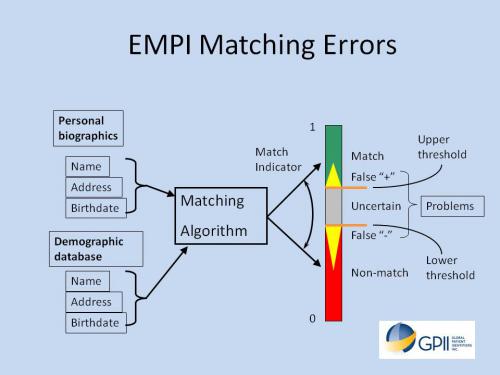
Today, the process that a healthcare organization uses to identify a patient is as follows:
- Obtain demographic information such as name, date of birth, etc.
- Compare this information against the database of patients
- Determine whether or not there is a match
- Either, connect this patient to an existing record or create a new record
Sophisticated software algorithms are used to determine whether of not a match is found. Unfortunately, error levels are still high for several reasons:
- Data may be entered incorrectly
- The demographics of several people may be identical or similar
- When the algortithm is "unsure" manual intervention, which is error prone, and costly, is required
- As healthcare populations increase the probability of matching errors increases
For those who are interested in the technical explanation:
Healthcare organizations use software called an Enterprise Master Person Index (EMPI) to compare that person's biographic profile with the various records in its database. The figure shows how this process works. The result of EMPI processing is an identification likelihood, but unfortunately there is always the possibilty of error. Industry literature reports error rates ranging from 5% to 10% or even higher.
There are two types of error. A 'false positive' error occurs when the EMPI thinks that two sets of information are about the same person, but in reality they are not. This error means that the information system will mix the medical information of two patients - a very dangerous situation. A 'false negative' error occurs when the EMPI thinks that two sets of information pertain to two different people, but in reality they are about the same person. This error means that the information system will create a duplicate patient record and the information in that duplicate record may be unavailable when it is needed.
What does GPII offer?
GPII Services can dramatically improve the performance of an EMPI to virtually eliminate errors. GPII provides a unique data element (the <prTag>) to the EMPI that the EMPI attaches to the patient record - this then identifies their information without error.
For more details on how GPII works with EMPI software see the technical section.
For an in depth discussion of EMPI systems see (HIMSS PII white paper)